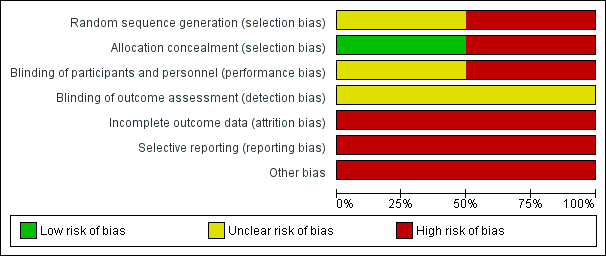Contenido relacionado
Revisiones y protocolos relacionados
Diego N Araujo, Cibele TD Ribeiro, Alvaro CC Maciel, Selma S Bruno, Guilherme AF Fregonezi, Fernando AL Dias | 14 junio 2023
Sarah L Knight (nee Shingler), Lindsay Robertson, Marlene Stewart | 16 julio 2021
Melissa Andreia de Moraes Silva, Luis CU Nakano, Lígia L Cisneros, Fausto Miranda Jr | 9 enero 2023
Maria José Martinez-Zapata, Robin WM Vernooij, Daniel Simancas-Racines, Sonia Maria Uriona Tuma, Airton T Stein, Rosa Maria M Moreno Carriles, Emilio Vargas, Xavier Bonfill Cosp | 3 noviembre 2020
Max H Pittler, Edzard Ernst | 14 noviembre 2012
Risha Lane, Amy Harwood, Lorna Watson, Gillian C Leng | 26 diciembre 2017
Lindsay Robertson, James Strachan | 14 febrero 2017
Charlie C‐T Hsu, Gigi NC Kwan, Dalveer Singh, John A Rophael, Chris Anthony, Mieke L van Driel | 8 diciembre 2018
Sergi Bellmunt-Montoya, Jose Maria Escribano, Percy Efrain Pantoja Bustillos, Cristina Tello-Díaz, Maria José Martinez-Zapata | 30 septiembre 2021
Stephen Badger, Rachel Forster, Paul H Blair, Peter Ellis, Frank Kee, Denis W Harkin | 26 mayo 2017




![Forest plot of comparison: 1 Ejection fraction, outcome: 1.1 Ejection fraction [%].](/es/cdsr/doi/10.1002/14651858.CD010637.pub2/media/CDSR/CD010637/rel0002/CD010637/image_n/nCD010637-AFig-FIG04.png)
![Forest plot of comparison: 2 Venous refilling time, outcome: 2.1 Half refilling time [seconds].](/es/cdsr/doi/10.1002/14651858.CD010637.pub2/media/CDSR/CD010637/rel0002/CD010637/image_n/nCD010637-AFig-FIG05.png)
![Forest plot of comparison: 2 Venous refilling time, outcome: 2.2 Total refilling time [seconds].](/es/cdsr/doi/10.1002/14651858.CD010637.pub2/media/CDSR/CD010637/rel0002/CD010637/image_n/nCD010637-AFig-FIG06.png)



